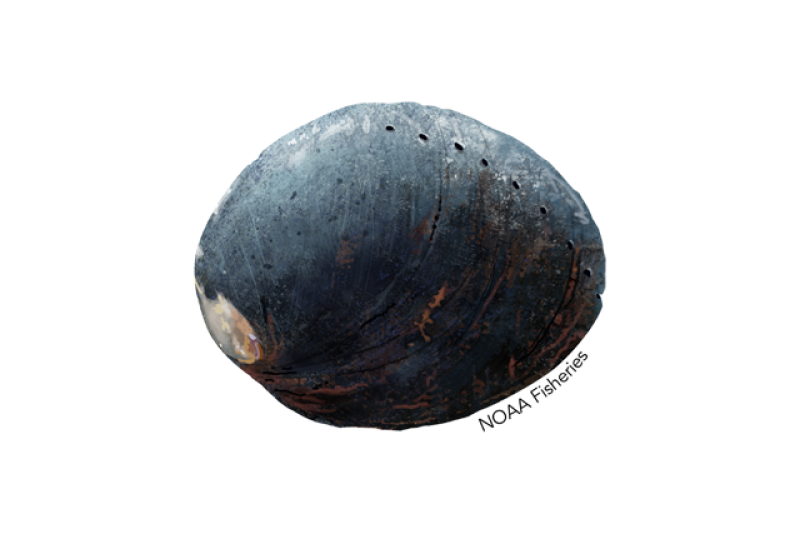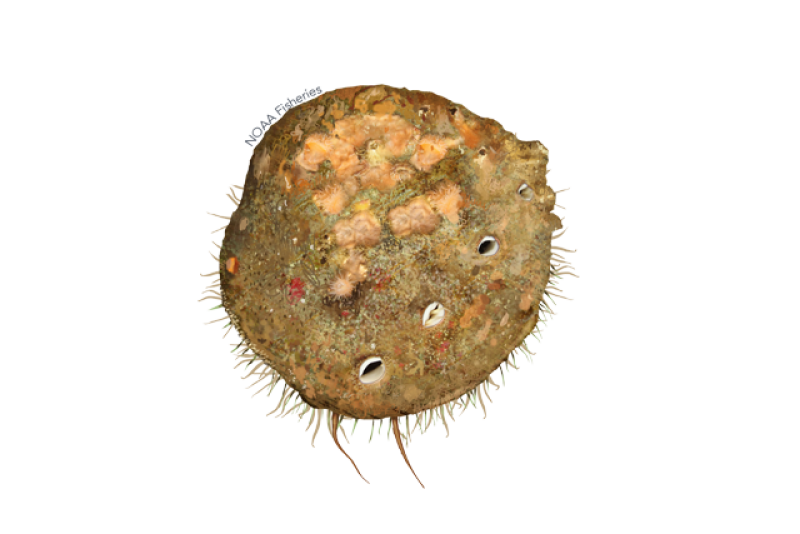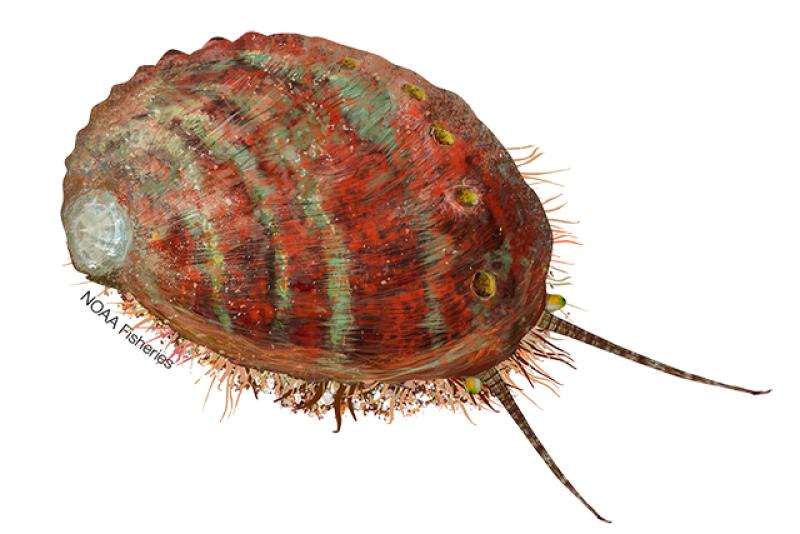Green Abalone
Haliotis fulgens
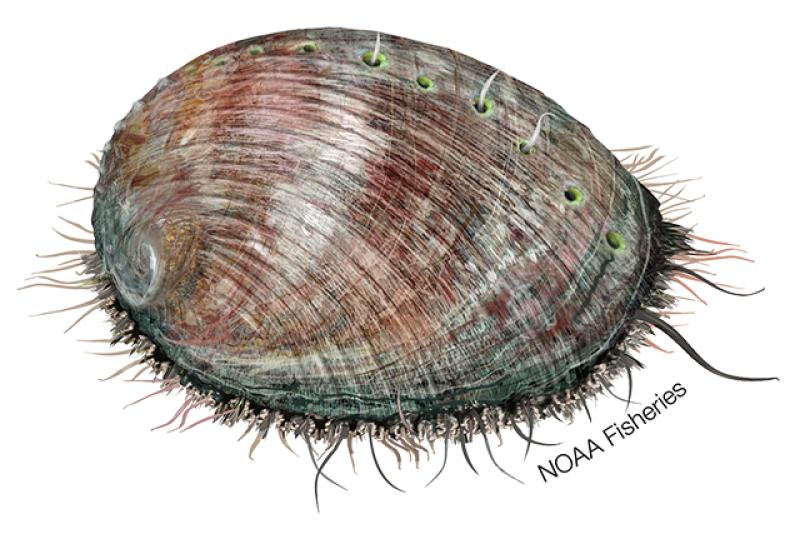
Quick Facts

About the Species

Green abalone are marine snails with one shell and a strong, muscular “foot” that they use to move and to grip onto hard surfaces. Green abalone range from Point Conception, California, to Bahia de Magdalena, Mexico. They live in shallow water on open or exposed coast from the low intertidal to at least 30 feet and perhaps as deep as 60 feet. They are found in rock crevices, under rocks, and other cryptic spaces.
The oval-shaped shell protects the abalone from predators. The shell is usually brown and marked with many low, flat-topped ribs which run parallel to the 5 to 7 open respiratory pores that are elevated above the shell’s surface. The inside of the shell is an iridescent blue and green. The epipodium is a “ruffle” of tissue along the side of the foot. The cephalic (head) and epipodial tentacles are olive green, but the epipodial fringes are a mottled cream and brown, with tubercles scattered on the surface and a frilly edge (California Department of Fish and Game 1986).
Green abalone have separate sexes and spawn from early summer through early fall. They reach maturity at 2.4 to 5 inches in length or 5 to 7 years, and can live to 30 years or more. Being herbivores, they feed mostly on drift algae and prefer fleshy red algae.
Threats
Demographic and Genetic Diversity Concerns
Population size has declined in many areas. In California, commercial landings peaked in the early 1970’s and have since declined precipitously. Reduced numbers make the species vulnerable to local extinction due to a phenomenon known as the Allee effect (Allee et al. 1949). The Allee effect describes a situation whereby a decrease in population size leads to decreases in reproduction and survival of individuals. In the case of green abalone, this effect is likely due to increased distance between males and females as the population density decreases, leading to reproductive failure.
Factors for Decline
The primary factors contributing to the decline of green abalone are overharvest, suspected illegal harvest, and trade. Other factors include disease (withering syndrome) and elevated water temperatures (e.g., due to El Niño, warm water events).
In California, green abalone were targeted after the collapse of the pink abalone fishery in 1970. Landings of green abalone peaked in 1971 (> 494 metric tons). By 1990, the landings had declined to 6% of the average in 1968-1972. In 1996, the California Department of Fish and Game (now California Department of Fish and Wildlife) closed the commercial and recreational abalone fisheries in southern California, but populations continued to decline.
Information regarding the status of green abalone in Mexico is scant. Aquaculture programs have been developed to artificially enhance populations. A commercial fishery for green abalone continues to operate in Mexico and is managed by local cooperatives.
References
- Allee, W.C., A.E. Emerson, O. Park, T. Park, and K.P. Schmidt. 1949. Principles of Animal Ecology. Saunders, Philadelphia, Pennsylvania, USA.
- California Department of Fish and Game. 1986. California Abalone, Marine resources Leaflet No. 11, Marine Resources Division, Long Beach, California, USA.
- California Department of Fish and Game. 2005. Abalone recovery and management plan.
Last updated by NOAA Fisheries on 09/30/2022
Management Overview
Existing protections for green abalone include a system of California Marine Protected Areas, commercial and recreational fishery closures, and an Abalone Recovery Management Plan that was adopted in 2005.
In 2009, NOAA Fisheries partnered with the Redondo SEA Lab to develop broodstock conditioning and captive propagation and rearing methods for green abalone. In 2011, this work expanded with a partnership between NOAA Fisheries, NOAA Restoration Center, and several organizations throughout southern California. Together, we examined the genetic structure of green abalone populations along the southern California coast and developed in-situ disease screening techniques.
Since 2013, NOAA Fisheries has partnered with The Bay Foundation to continue green abalone restoration efforts. Together, we continue to develop propagation techniques for green abalone and outplanting methods for larval and juvenile abalone. This work will contribute to the long-term goal to restore green abalone populations throughout the southern California coast, as well as inform restoration efforts for the endangered white abalone.
Spawning, measuring, and swabbing for disease screening are all part of a broodstock and propagation program with NOAA Fisheries and their many partners.
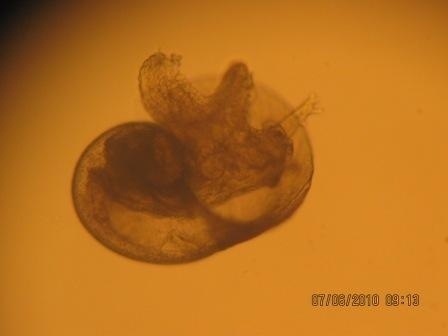

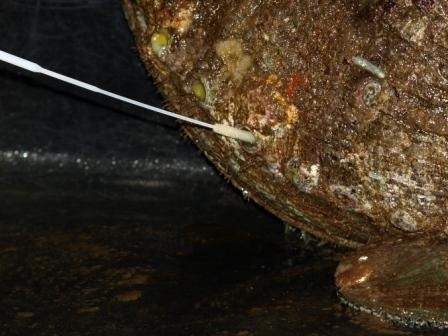
Abalone Workshop
In September 2009, NOAA Fisheries held a joint workshop for abalone on the U.S. West Coast. The workshop focused on the three abalone species: green abalone, pink abalone, and pinto abalone. The purposes of this workshop were to bring together current and potential partners to:
- Build partnerships
- Gather information about the species’ status, threats, and research and conservation needs
- Identify research and conservation actions to address threats to the species
The workshop discussions and outcomes are summarized in the Abalone Workshop Report.
For more information about green abalone, please contact:
- Melissa Neuman at melissa.neuman@noaa.gov or (562) 980-4115
- Susan Wang at susan.wang@noaa.gov or (562) 980-4199
Resources & Partners
Last updated by NOAA Fisheries on 09/30/2022
Research
Abalone Research in the Southwest
This research focuses on our local abalone species to develop methods to support and expand commercial aquaculture in the region as well as aid in restoration programs for federally endangered black and white abalone.
Genetics, Physiology and Aquaculture in the Pacific
We conduct research across multiple focal areas and species through genetic and physiological tools to provide improved data products for managers and industry.
Last updated by NOAA Fisheries on 09/30/2022
